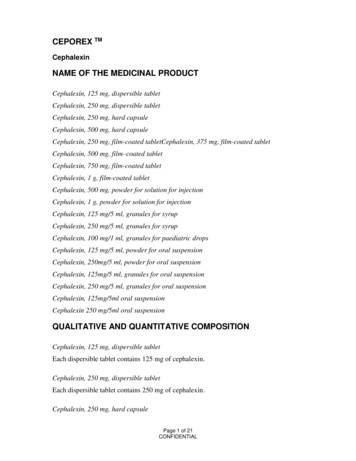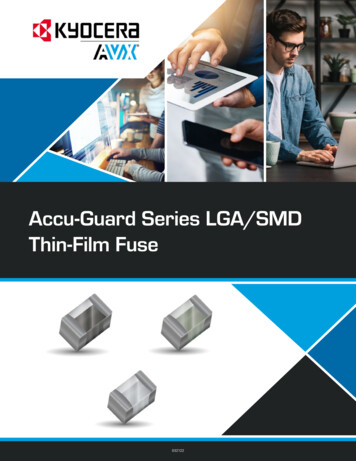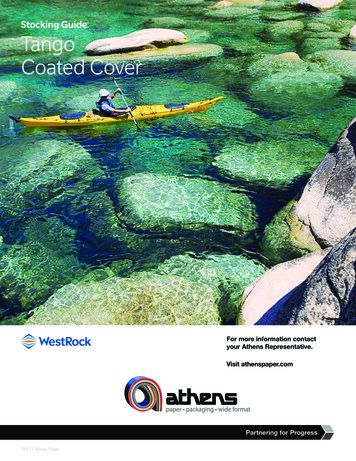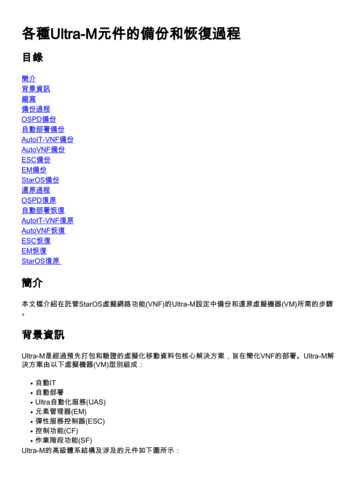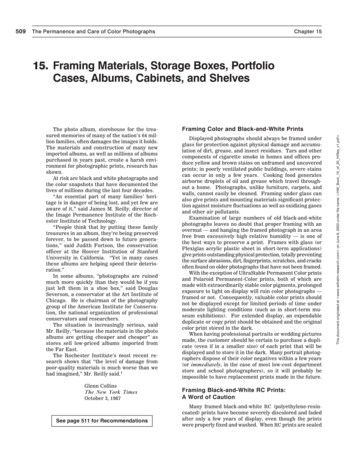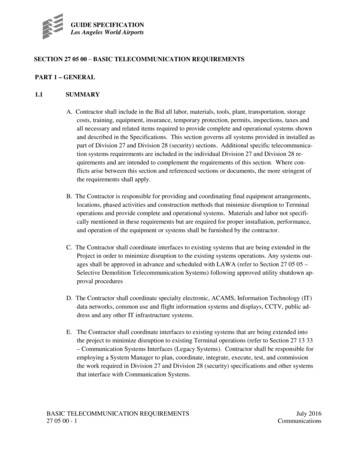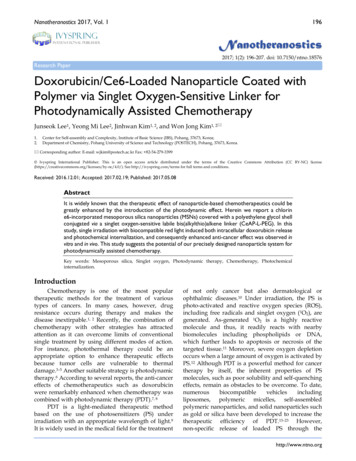
Transcription
Nanotheranostics 2017, Vol. 1IvyspringInternational Publisher196Nanotheranostics2017; 1(2): 196-207. doi: 10.7150/ntno.18576Research PaperDoxorubicin/Ce6-Loaded Nanoparticle Coated withPolymer via Singlet Oxygen-Sensitive Linker forPhotodynamically Assisted ChemotherapyJunseok Lee1, Yeong Mi Lee2, Jinhwan Kim1, 2, and Won Jong Kim1, 2 1.2.Center for Self-assembly and Complexity, Institute of Basic Science (IBS), Pohang, 37673, Korea;Department of Chemistry, Pohang University of Science and Technology (POSTECH), Pohang, 37673, Korea. Corresponding author: E-mail: wjkim@postech.ac.kr Fax: 82-54-279-3399 Ivyspring International Publisher. This is an open access article distributed under the terms of the Creative Commons Attribution (CC BY-NC) /4.0/). See http://ivyspring.com/terms for full terms and conditions.Received: 2016.12.01; Accepted: 2017.02.19; Published: 2017.05.08AbstractIt is widely known that the therapeutic effect of nanoparticle-based chemotherapeutics could begreatly enhanced by the introduction of the photodynamic effect. Herein we report a chlorine6-incorporated mesoporous silica nanoparticles (MSNs) covered with a polyethylene glycol shellconjugated via a singlet oxygen-sensitive labile bis(alkylthio)alkene linker (CeAP-L-PEG). In thisstudy, single irradiation with biocompatible red light induced both intracellular doxorubicin releaseand photochemical internalization, and consequently enhanced anti-cancer effect was observed invitro and in vivo. This study suggests the potential of our precisely designed nanoparticle system forphotodynamically assisted chemotherapy.Key words: Mesoporous silica, Singlet oxygen, Photodynamic therapy, Chemotherapy, apy is one of the most populartherapeutic methods for the treatment of varioustypes of cancers. In many cases, however, drugresistance occurs during therapy and makes thedisease inextirpable.1, 2 Recently, the combination ofchemotherapy with other strategies has attractedattention as it can overcome limits of conventionalsingle treatment by using different modes of action.For instance, photothermal therapy could be anappropriate option to enhance therapeutic effectsbecause tumor cells are vulnerable to thermaldamage.3–5 Another suitable strategy is photodynamictherapy.6 According to several reports, the anti-cancereffects of chemotherapeutics such as doxorubicinwere remarkably enhanced when chemotherapy wascombined with photodynamic therapy (PDT).7, 8PDT is a light-mediated therapeutic methodbased on the use of photosensitizers (PS) underirradiation with an appropriate wavelength of light.9It is widely used in the medical field for the treatmentof not only cancer but also dermatological orophthalmic diseases.10 Under irradiation, the PS isphoto-activated and reactive oxygen species (ROS),including free radicals and singlet oxygen (1O2), aregenerated. As-generated 1O2 is a highly reactivemolecule and thus, it readily reacts with nearbybiomolecules including phospholipids or DNA,which further leads to apoptosis or necrosis of thetargeted tissue.11 Moreover, severe oxygen depletionoccurs when a large amount of oxygen is activated byPS.12 Although PDT is a powerful method for cancertherapy by itself, the inherent properties of PSmolecules, such as poor solubility and self-quenchingeffects, remain as obstacles to be overcome. To es, polymeric micelles, self-assembledpolymeric nanoparticles, and solid nanoparticles suchas gold or silica have been developed to increase thetherapeutic efficiency of PDT.13–23 However,non-specific release of loaded PS through thehttp://www.ntno.org
Nanotheranostics 2017, Vol. 1destruction of the carrier would give rise todiminishing efficiency and may cause severe sideeffects. Unlike conventional chemotherapy, therelease of the loaded PS is not a prerequisite for PDTsince the molecule in action is not the PS itself. Thus,the introduction of PS as a conjugated form into asolid nanoparticle would be an alternative for thesuccessful delivery of PS.18, 24Interestingly, it has been reported that thephotodynamic effect can enhance the therapeuticeffect of nanoparticle-mediated chemotherapy. Afterentering a cell by endosomal uptake, when thenanoparticles are irradiated with light to induce thephotodynamic effect, the endosomal membrane isoxidized by as-generated ROS and further zation (PCI).25, 26 Thus, since the delivereddrug is easily degraded in the endosomalenvironment, it is possible to take advantage of PCI toassist with the successful intracellular release ofdelivered chemotherapeutics. In that point of view,the combination of PS and an 1O2-cleavable linkercould be good strategy to render a photodynamicallycontrollable drug delivery platform.27 Under a singleirradiation with light, 1O2 is generated, which can notonly trigger drug release but also facilitate endosomalescape. Moreover, a dual effect of PDT by 1O2 andchemotherapy by released chemotherapeutics can beexpected as aforementioned. Therefore, thedevelopment of a photodynamically controlled drugdelivery system would be promising in an advanced197photo-responsive platform.Previously, our group has reported a drugrelease system that is responsive to long-wavelengthlight based on mesoporous silica nanoparticles(MSNs).28 In this system, a PS responsive tolong-wavelength light was loaded into the porousstructure of MSNs, and a model fluorescent dye wasconjugated on the surface via a singletoxygen-sensitive linker (SOSL). Irradiation withlong-wavelength light generated 1O2 and readilybroke the SOSL, triggering the highly sensitive releaseof the model drug from the surface.Inspired by previous reports by Singh et al. andour group, we further developed these studies bydesigning an MSN-based drug release system with an1O -responsive PEG shell on the surface.21, 29 Scheme 12illustrates the photo-responsive drug release systemconsisting of MSNs with chlorin e6 (Ce6) conjugatedin a porous structure and PEG conjugated by a SOSLon the surface of the MSNs. Similar to the results of aprevious study, 1O2 was generated upon irradiationwith red light (660 nm) and was utilized for bothphotodynamically triggered drug release andphotodynamic therapy. Furthermore, 1O2 mediatedthe endosomal escape of the nanoparticles, and drugrelease were expected. Since a single herapy simultaneously the potential forenhanced cancer therapy was evaluated in vitro and invivo.Scheme 1. Schematic illustration of photo-responsive drug releasing system triggered by as-generated singlet oxygen from the photo-activation of photosensitizerunder irradiation with red light, and intracellular behavior of delivered nanoparticle.http://www.ntno.org
Nanotheranostics 2017, Vol. 1198Materials and methodsPreparation of Ce6-conjugated andamine-modified mesoporous silica ugated mesoporous silica (CeAP) wasprepared by the reported method with somemodification.2 200 mg of CTAB was dispersed in 96mL of distilled water (DW) and 700 μL of 2 M NaOHsolution was added. The suspension was stirred at 80oC for 30 min and 1 mL of TEOS and 1 mL ofas-prepared Ce6-TES solution in DMF were added.117 μL of APTES was added after 15 min and furtherstirred for 2 h. Reaction mixture was centrifuged(13,000 rpm, 30 min) to isolate the nanoparticle andwashed with DW and MeOH to remove the unreactedmixture. The product was dispersed in 5 mL of MeOHwith addition of concentrated HCl (50 μL) andrefluxed for overnight. Suspension was centrifuged(13,000 rpm, 30 min) and the pellet washed by PBSand MeOH for several times and dried in vacuo. Thesurface amine group was quantified by fluorescamineassay. The loaded Ce6 was quantified by the UV-visabsorbance (664 nm) in DMSO to minimize thescattering of silica.Cetyltrimethylammonium bromide (CTAB),sodium hydroxide (NaOH), tetraethyl orthosilicate(TEOS), (3-aminopropyl)triethyoxysilane (APTES),3-mercaptopropionic acid (3-MPA), ol) diacrylate (PEGDA; MW 700),ammonium persulfate (APS), N,N,N’,N’-Tetramethylethylenediamine (TEMED) and thiazolyl bluetetrazolium bromide (MTT) were purchased fromSigma Aldrich. 30 wt % NaOMe in MeOH waspurchased from Acros. Singlet oxygen sensor green (SOSG) reagent was purchased from MolecularProbes (Eugene, OR). Doxorubicin hydrochloride(DOX) was purchased from Wako Chemical (Japan).Chlorin e6 (Ce6) was purchased from FrontierScientific (Logan, UT). All reagents were used asreceived without further purification. DMF was driedunder CaH2 and distilled.Instrumental methodsTEM image was taken from a transmissionelectron microscope (JEM-2210, JEOL) and analysedby Gatan DigitalMicrograph software. UV-vis spectrawere measured from a UV-vis spectrometer (UV 2550,Shimadzu) and fluorescence spectra were measuredfrom a spectrofluorophotometer (RF-5301 PC,Shimadzu). Hydrodynamic volume was measuredfrom zetasizer (Nano S90, Malvern) at 0.1 mg/mL inphosphate buffered saline (PBS) and zeta potentialwas measured from zetasizer (Nano Z, Malvern) at 0.1mg/mL in PBS. Confocal laser scanning microscope(CLSM) image was obtained from Olympus FV-1000and analysed by OLYMPUS FLUOVIEW ver. 1.5Viewer software.Preparation of photosensitizer conjugatedorganosilane (Ce6-TES)Ce6-TES was prepared by amide couplingreaction between COOH of Ce6 and NH2 of APTES(Scheme S1).1 Briefly, 105 mg of Ce6 (0.177 mmol)was dissolved in 10 mL of dry DMF. 170 mg ofEDC-HCl and 115 mg of NHS were added into thesolution (both 5 eq) and 207 μL of APTES (5 eq) wasadded after 15 min of activation. The solution wasstirred at RT for overnight. The final product wasintroduced for the synthesis of mesoporous silicawithout further purification.Synthesis of singlet oxygen sensitive linker(SOSL)SOSL was prepared by our previous report.3Briefly, 3-MPA (1.7 mL, 19.57 mmol) was activated by30 wt % NaOMe in MeOH (7.34 mL, 39.14 mmol) at 0oC and the disodium salt of 3-MPA was dried in vacuo.The solution of cis-1,2-dichloroethylene (781 μL, 10.3mmol) in EtOH (500 μL) was added into the 3-MPAsuspension in DMF (10 mL) by dropping and themixture was stirred at RT for 18 h. The solution wasdiluted with water (50 mL) and pH was adjusted to 3by 1 M KHSO4. The product was extracted by EtOAc(3 x 100 mL) and the combined organic layers werewashed with water (2 x 100 mL) and brine (100 mL),dried with dry Na2SO4 and concentrated. Crudeproduct was washed with diethyl ether to obtain thewhite powder and recrystallized with EtOAc /Hexane and dried under vacuum. (Yield 64 %)Preparation of SOSL-conjugated CeAP(CeAP-L) or singlet oxygen non-sensitiveCeAP (CeAP-SA)Singlet oxygen sensitive linker (SOSL) wasconjugated on the surface of CeAP by amide couplingreaction. The CeAP (57 mg, 7.31 μmol of amine) wasdispersed in DMSO (1 mL) by sonication. SOSL (8.6mg, 5 eq of amine), EDC-HCl (35 mg, 25 eq) and NHS(21 mg, 25 eq) were dissolved in 4 mL of DMSO andstirred for 30 min. CeAP suspension was added intothe reaction mixture and stirred at dark for overnight.Final product was obtained by centrifugation (13,000http://www.ntno.org
Nanotheranostics 2017, Vol. 1199rpm, 10 min), washed with DMSO, DW and MeOHand dried in vacuo. Conjugated amount of SOSL wasback-titrated through the quantification of remainedamine by fluorescamine assay.For control experiment, SOSL was altered bysuccinic anhydride (SA).4 Briefly, 10 mg CeAP wasdispersed in dry DMF (5 mL) and SA (3.7 mg, 5 eq toamine) as 1 mL of DMF suspension was added. Thereaction mixture was stirred at dark for overnight andthe final product was obtained by centrifugation(13,000 rpm, 10 min). Obtained CeAP-SA was washedwith DMF, DW and MeOH and dried in vacuo.Conjugated amount of SA was back-titrated throughthe quantification of remained amine byfluorescamine assay.Generation of singlet oxygen from CeAP andfree Ce6 was measured by the fluorescence at 530 nmfrom the reacted product of SOSG and singletoxygen.6 CeAP was dispersed in PBS to finalconcentration of 0.1 mg/mL or same equivalence ofCe6 (2.3 μM) was dispersed and SOSG was added intothe suspension to final concentration of 10 μM.Suspension was irradiated by red laser (660 nm diodelaser, Shanghai dream lasers, China) with finalintensity of 100 mW/cm2. Fluorescence of reactedSOSG (ex 504 nm / em 528 nm) was measured atdifferent time scales (0, 10, 20, 30, 45, 60 min). Controlexperiment was operated by incubation in a darkcondition.Preparation of allyl-conjugated CeAP-L(CeAP-L-M)Photo-responsive release of DOX fromDOX@CeAP-L-PEGAllyl group was introduced on the surface ofCeAP for further radical polymerization.5 Briefly, 19.5mg of CeAP-L (1.90 μmol of COOH), 18 mg ofEDC-HCl (50 eq) and 11 mg of NHS (50 eq) weredispersed in 2 mL of DMSO. 3 μL of allylamine (20 eq)was then introduced after 30 min of stirring andfurther stirred at dark for overnight. Final productwas obtained by centrifugation (13,000 rpm, 10 min)and washed with DMSO, DW and MeOH. CeAP-SAwas applied for control experiment in a same mannerand CeAP-SA-M was obtained.Preparation of 1O2-sensitive PEG-coated CeAP(CeAP-L-PEG)Singlet oxygen sensitive PEG was coated on theCeAP by polymerization.5 CeAP-L-M was uniformlydispersed in DW as 2 mg/mL suspension and 1 MPEGDA (9.6 μL), 0.1 M APS (20 μL) and TEMED (16μL) was added. The reaction mixture was stirred atdark for overnight and CeAP-L-PEG was obtained bycentrifugation. CeAP-SA-M was utilized for controlexperiment and CeAP-SA-PEG was obtained in asame manner.Loading doxorubicin in CeAP-L-PEG(DOX@CeAP-L-PEG)Doxorubicin (DOX), a typical anticancer drug,was loaded in CeAP-L-PEG by diffusion. Briefly, 10mg of CeAP-L-PEG was dispersed in 10 mL of 1mg/mL DOX solution in DW and stirred at dark forovernight. Final product was obtained bycentrifugation (13,000 rpm, 10 min) and washed withDW. For quantification of loaded DOX, final productwas dispersed in MeOH and fluorescence of extractedDOX (ex 495 nm / em 555 nm in MeOH) wasmeasured. DOX was loaded in CeAP-SA-PEG forcontrol experiment.Detection of singlet oxygenIn order to evaluate the photo-responsive drugrelease from DOX@CeAP-L-PEG, 0.1 mg/mLsuspension of DOX@CeAP-L-PEG in buffer (PBS forpH 7.4; acetate buffer for pH 5.0) was irradiatedby a red laser (660 nm, 150 mW/cm2). 200 μL aliquotof the suspension was collected at predetermined timeintervals and centrifuged to measure the fluorescenceof DOX (ex 495 nm / em 555 nm) from thesupernatant. A similar suspension incubated inabsence of any light was used as a negative control.For control experiment, DOX@CeAP-SA-PEG wasassessed by the same procedure.Cell viability testNonspecific cytotoxicity of laser itself and thedose-dependent cytotoxicity of free DOX wasmeasured. Cells (8000 cells/well; HeLa for lasertoxicity; HeLa, PC-3, Hep3B and HCT-8 for DOXtoxicity) were seeded on 96 well culture plates andincubated for overnight. For the nonspecific toxicity ofirradiation, cells were irradiated by red laser (660 nm,diode laser) under fresh medium for 0, 3, 6, 9, 12 or 15min and further incubated for 24 h. For free DOXtoxicity, medium was replaced by fresh mediumcontaining 0 to 20 μM of DOX (HeLa and PC-3) or 0 to50 μM (Hep3B and HCT-8) and further incubated for24 h. After incubation, cell viability was evaluated byMTT assay.For MTT assay, medium was replaced by 180 μLof fresh medium and 20 μL of MTT solution (5mg/mL) was added. After incubation at dark for 4 h,medium was removed and purple formazan crystalwas completely dissolved by 200 μL of DMSO. 100 μLof each solution was transferred into a 96 well plateand UV-vis absorbance at 570 nm was measured by amicroplatespectrofluorometer(VICTOR3Vmultilabel counter). The relative percentages ofhttp://www.ntno.org
Nanotheranostics 2017, Vol. 1200non-treated cells were used to represent 100 % of cellviability.CLSM with excitation at 470 nm and emission at 556nm and false-imaged as red.7Photo-triggered cytotoxicity in vitroPhotochemical internalization (PCI) basedendosomal escape monitored by CLSMThe dose-dependent cytotoxicity of free Ce6 withand without irradiation was evaluated. Cells (8000cells/well, HeLa, PC-3, Hep3B and HCT-8) wereseeded on 96 well culture plates and incubated forovernight. Medium was replaced by fresh serum-freemedium containing 0 to 500 ng/mL of Ce6 andincubated for 4 h. After incubation, cells were washedwith PBS and medium was replaced to fresh medium.Cells were then irradiated by red laser (660 nm diodelaser, Shanghai dream lasers, China) with powerdensity of 150 mW/cm2 for 15 min or incubated atdark and cytotoxicity was measured by MTT assayafter further incubation for 24 h.Cytotoxicity of photo-responsive nanoparticleswith and without irradiation were evaluated undervarious concentration. Cells (8000 cells/well, HeLa,PC-3, Hep3B and HCT-8) were seeded on 96 wellculture plates and incubated for overnight.DOX@CeAP-L-PEG at final concentration of 0 to 20μg/mL CeAP-L-PEG at final concentration of sameCe6 equivalency compared to DOX@CeAP-L-PEGwas treated under serum-free medium and incubatedfor 4 h. Cells were then washed with PBS andirradiated by laser with power density of 150mW/cm2 for 15 min or incubated at dark under freshmedium and further incubated for 24 h, followed byMTT assay. For control experiment, SA-PEG) with and without irradiation wasevaluated. Photo-toxicity at final concentration ofsame equivalency of Ce6 against HeLa cell wasevaluated in a same manner.Intracellular release of DOX observed byconfocal laser scanning microscopy (CSLM)Intracellular releasing property of DOXfacilitated by red laser irradiation was analysed byconfocal microscopy image. Briefly, HeLa cells (50,000cells/well) were seeded on the glass cover slipsplaced in a 12 well culture plate and incubated forovernight. Medium was replaced by fresh serum-freemedium containing 10 μg/mL DOX@CeAP-L-PEG orDOX@CeAP-SA-PEG. After 4 h of incubation, cellswere washed carefully and irradiated by red laser(150 mW/cm2) for 10 min under fresh medium. Cellswere washed with PBS and fixed immediately with 10% neutrally buffered formalin (NBF) just afterirradiation or after 4 h of further incubation. Cells onthe coverslip were mounted by Vectashield anti-fademounting medium including DAPI (Vector Labs).Intracellular fluorescence of DOX was observed byIn order to prove the photodynamicallytriggered endosomal escape, the localization of thecarrier (CeAP-L-PEG) and the endo-lysosome wereobserved by confocal microscope. Briefly, HeLa cell(20,000 cells/well) was seeded on the glass cover slipsplaced in a 12 well culture plate and incubated forovernight. Then, medium was replaced by freshserum-freemediumcontaining5μg/mLCeAP-L-PEG and incubated for 4 h. Cells wereirradiated by 660 nm laser (150 mW/cm2) for 10 minand lysotracker was added immediately at the finalconcentration of 4 μM. After 5 min of incubation,cellular uptake was blocked by cold DPBS and cellswere washed thoroughly, finally fixed with 10 %neutrally buffered formalin (NBF) for overnight at 4oC. Cells on the coverslip were mounted inVectashield anti-fade mounting medium includingDAPI (Vector Labs) and observed with CLSM.Fluorescence of lysotracker was false-imaged as greenand Ce6 from CeAP-L-PEG was pseudo-coloured asred.In vivo experimentAll animal experiments were approved by thePostech Biotech Center Ethics Committee. Cells (1 x106 CT26 cells) were inoculated subcutaneously (s.c.)into the flank of each female Balb/c mice weighing 17 2 g. After the average tumor volume reached 100mm2, the mice were randomly divided into six groups(five mice per group) and treated with 100 μL ofphysiological saline, free DOX, free Ce6,CeAP-L-PEG,DOX@CeAP-SA-PEGandDOX@CeAP-L-PEG (2 mg/kg DOX and 83 μg/kgCe6), intratumorally (i.t.). After 6 h of sampleinjection, mice were irradiated by the red laser (660nm, 150 mW/cm2, 20 min). The antitumor effectagainst CT26 cell was evaluated by measuring tumorvolume. Each tumor volume was calculated from twodimensions measured by electronic calliper at desiredtime interval, by formula for a prolate ellipsoid; tumorvolume was calculated as ab2/2 where a is the longestand b is the shortest dimension. The tumor growthwas monitored until the 15 days after sampleinjection, at the time when mice were sacrificed. Inorder to demonstrate the statistical differences,Student’s t-test was performed (**p 0.01 and ***p 0.001). Furthermore, the tumor tissue of one mouseper group sacrificed at day 15 were collected forhistological evaluation.http://www.ntno.org
Nanotheranostics 2017, Vol. 1201Figure 1. Illustration and TEM images of A) CeAP and B) CeAP-L-PEG. C) Photo-triggered generation of singlet oxygen determined by fluorescence of SOSG. D)Photo-responsive drug release of DOX@CeAP-L-PEG in vitro.Results and discussionSynthesis and characterization of the drugcarrier (DOX@CeAP-L-PEG)In order to introduce the red light-responsive PSin the channel of the MSNs, Ce6-conjugatedorganosilane (Ce6-TES) was synthesized by roughEDC-NHS chemistry.18 As-prepared Ce6-TES odified MSNs (CeAP), synthesizedby following a previous report with somemodifications.30 TEM imaging showed that the MSNsshowed a kidney-like shape (longitudinal 160 nm,transverse 80 nm), which may be the result ofhydrophobic interactions between Ce6-TES andCTAB, corresponding to the results of a previousreport (Figs. 1A, S1A).31 The UV-vis spectra of Ce6,Ce6-TES, and CeAP showed the inherent absorptionof the Soret- and Q-band of the Ce6 molecule,indicating the non-aggregated nature of Ce6molecules (Figs. S1B-C). In addition, the amount ofCe6 in CeAP was quantified by UV-vis absorptionand it was calculated to be 13.6 mg per g ofnanoparticles.Since Ce6 is chemically confined in the channelstructure of CeAP, stable generation of 1O2 should beconfirmed to achieve photodynamically triggereddrug release. Photosensitized generation of 1O2 wasmonitored by the fluorescence of singlet oxygensensor green (SOSG) under irradiation with a redlaser (660 nm).32 As shown in Fig. 1C, free Ce6 andCeAP exhibited similar maximum intensities of SOSGfluorescence, which reveals the preserved activity ofthe Ce6 molecule in CeAP. Interestingly, there was adifference between the time required to reach themaximum intensity of 1O2 (10 min for free Ce6; 30 minfor CeAP) and it is thought to be a result of thedifferent accessibilities of triplet oxygen between Ce6in the solution state and in the silica channel as aconfined structure. This result implies the potential ofCeAP as a template for the photodynamically assisteddrug releasing system.For the next step, the SOSL was synthesized andconjugated on the surface of CeAP to introduce 1O2sensitivity, following our previous report, andCeAP-L was obtained.28 The synthesis of SOSL wasconfirmed by 1H NMR and Fourier transform infrared(FT-IR) spectroscopy (Fig. S2). The conjugatedamount of linker was determined through an indirectquantification of residual primary amine byfluorescamine assay.33 The amount of –NH2 moiety onCeAP and –COOH moiety on CeAP-L were calculatedto be 128 and 97.7 μmol per g of washttp://www.ntno.org
Nanotheranostics 2017, Vol. 1conjugated by EDC-NHS chemistry for furtherpolymerization, and PEG was conjugated by radicalpolymerization between allylamine and poly(ethyleneglycol) diacrylate to obtain the nanoparticleCeAP-L-PEG. Successful functionalization of eachmodification step was revealed by the zeta potentialscorresponding to amine (CeAP), carboxylic acid(CeAP-L), allylamine (CeAP-L-M), and PEG(CeAP-L-PEG) on the surface (Fig. S1D). Theformation of the polymeric shell on the surface ofCeAP was also confirmed by TEM imaging (Fig. 1B).In order to set up an 1O2-insensitive negative control,the SOSL was altered with a succinic anhydride (SA)as an 1O2-insensitive linker to introduce the PEG shellon the surface of CeAP. The entire syntheticprocedure was performed in the same manner toobtain CeAP-SA-PEG.Following the synthesis of the bicin (DOX), was loaded in the PEG shell andthe porous structure of the MSNs to obtainDOX@CeAP-L-PEG. The amount of loaded DOX wasconfirmed by fluorescence after extraction inmethanol. The calculated quantity of loaded DOX was0.64 mg/g for DOX@CeAP-L-PEG and 0.60 mg/g forDOX@CeAP-SA-PEG, respectively.Photo-responsive drug releaseTo evaluate the photodynamically assisted drugrelease property, in vitro release profiles ofDOX@CeAP-L-PEG and DOX@CeAP-SA-PEG weremonitored in solution at different pH (pH 7.4 and 5.0)with or without irradiation of red light (660 nm, 150mW/cm2). As shown in Fig. 1D and Fig. S3, bothsystems exhibited pH-responsive drug releasebehavior. The accelerated release at acidic pH can beexplained by the inherent characteristics of the loadedDOX. At acidic pH, the solubility of DOX could beincreased by the protonation of the primary amine202and drug release was enhanced by the reducedinteraction between DOX and silica or the PEG shell.34The pH-induced drug release is a plausible behaviorfor successful intracellular drug release becauseduring maturation, endolysosomal pH becomes acidicin comparison with physiological conditions.35Besides the pH-responsive profile, photo-responsivedrug release was only observed from the drug carrierwhen the SOSL was introduced (Fig. 1D). Significantacceleration of drug release under irradiation with redlight was observed from DOX@CeAP-L-PEG, whichwas driven by the generation of 1O2 and furtherloosened linkage between silica and the PEG shell. Incontrast, only a negligible difference was observedfrom the release profile of 1O2-insensitiveDOX@CeAP-SA-PEG regardless of external stimulus.These results clearly indicate the potential ofCeAP-L-PEG as a photodynamically assisted drugrelease platform.In addition to the solution level, it is important toexhibit stimuli-responsive drug release at the cellularlevel to show effective anti-cancer behavior. To thatend, photo-responsive intracellular release of DOXwas visualized by confocal laser scanning L-PEGorDOX@CeAP-SA-PEG,irradiated by red light (150 mW/cm2) for 10 min, andobserved after 4 h. As demonstrated in Fig. 2, only theirradiated DOX@CeAP-L-PEG showed strongfluorescence signal from the nucleus region,indicating successful release of DOX and localizationinto the nucleus, where DOX works as an anti-cancerdrug. Meanwhile, all other samples showed DOXsignal mainly in the cytosolic regions, which couldindicate insufficient release of DOX from the carrier.21This result implies that DOX@CeAP-L-PEG exhibitsstimuli-responsive drug release behavior not only insolution but also at the cellular level.Figure 2. Confocal microscopic images of HeLa cells treated with DOX@CeAP-L-PEG (Linker) or DOX@CeAP-SA-PEG (Control) with or without irradiation of660 nm laser (150 mW/cm2). Nucleus was stained by DAPI (blue) and DOX was false-imaged as red. (scale bar 50 μm)http://www.ntno.org
Nanotheranostics 2017, Vol. 1Photo-responsive cytotoxicity andphotochemical internalizationAs aforementioned, a single irradiation with redlight can facilitate the generation of 1O2 and drugrelease from DOX@CeAP-L-PEG in a sequence. Asboth photodynamic therapy and chemotherapy wereexpected, the photo-responsive therapeutic effect ofDOX@CeAP-L-PEG was evaluated in vitro by MTTassay. To work as a stimuli-responsive drug deliverysystem, it is crucial that the cytotoxicity of the drugcarrier should be induced only when irradiated byspecific light. The stimulus condition used in thisstudy, irradiation with red light (660 nm laser, 150mW/cm2, maximum 15 min), did not induce anysignificant toxicity in vitro (Fig. S4). In the dark, onlynegligible cytotoxicity was shown when the cells weretreated nanoparticles, as expected, regardless of theloaded DOX (Figs. 3 and S6). Similar to the releasepattern in Fig. S3, the 1O2-insensitive system did notexhibit any notable difference in cytotoxicityregardless of the loaded drug, which reveals the203insufficient release of the loaded drug underirradiation. In the case of CeAP-L-PEG, the1O -sensitivenanoparticle without loaded DOX2caused slightly decreased viability under irradiation,which was possibly due to the photodynamic effectfrom the photo-activated Ce6 in the MSN core.Moreover, DOX@CeAP-L-PEG showed the highesttoxicity under irradiation with red light, representedby approximately 40% viability at a particleconcentration of 20 μg/mL in the HeLa and PC-3 celllines. In general, hepatocellular carcinoma and HCT-8cell lines are known to be resistant to conventionalchemotherapy including DOX.36–38 Interestingly, theequivalent IC50 values of DOX against Hep3B (12.7μM) and HCT-8 (21.6 μM) were significantly reducedin comparison with those of free DOX, which were40.3 μM for Hep3B and 38.7 μM for HCT-8 (Fig. S6B).These results demonstrate that DOX@CeAP-L-PEGcould be a practical alternative as a form of therapyfor chemo-resistant cancer.Figure 3. Photo-induced cytotoxicity of DOX@CeAP-L-PEG studied in A) HeLa, B) PC-3, C) Hep3B and D) HCT-8 cell line. (** p 0.01, *** p 0.001)http://www.ntno.org
Nanotheranostics 2017, Vol. 1In general, a nanoparticle-based drug deliverycarrier should be allowed to enter cells and release thecargo drug intracellularly. Cellular uptake ofnanoparticles is mainly followed by endocyticmechanisms involving acidification
by Gatan DigitalMicrograph software. UV-vis spectra were measured from a UV -vis spectrometer (UV 2550, Shimadzu) and fluorescence spectra were measured from a spectrofluorophotometer (RF-5301 PC, Shimadzu). Hydrodynamic volume was measured from zetasizer (Nano S90, Malvern) at 0.1 mg/mL in phosphate buffered saline (PBS) and zeta potential
